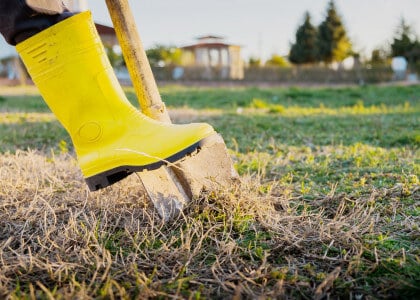Fall is the perfect season for football games, Saturday afternoon barbeques, picnics, and spending time in your yard and garden. Fall is also the perfect time for planting! The weather, moist soil conditions, and cooler temperatures are all aspects that make fall the optimal time for planting shrubs, trees, bulbs, and fall-flowering plants.
To make Fall planting a bit easier, here are 6 simple tips for planting success!

First, no matter when you’re planting, remember not to plant your plants too deeply in the ground. Most people kill plants by planting them too deep. Remember, the goal is to plant your shrub, not bury it.
PRO TIP: A good rule of thumb is to plant the hole twice as wide, but only as deep as the actual depth of the ball of dirt on the plant’s roots. Keep the level of the hole, and the level of where the plant was already growing level.

Second, be sure you give your plants adequate water, but avoid overwatering. Most plants need about one inch of water a week. As long as the ground is not frozen, you may need to water year-round. Check the soil to a depth of 3-4 inches. If it feels dry, you may need to add water. Slow, deep watering is better than sprinkling. Don’t forget that plants may need water throughout fall and winter too. For more on watering, check out our video below.

Third, fertilize your fall planting as you would your spring planting, but make sure you don’t fertilize late in the season. While you want to encourage root growth in fall plantings, you don’t want to encourage top growth. Choose a low-nitrogen “starter” fertilizer for new plants. Take a look at our specialty products on our website.

Fourth, consider the location of your plant carefully. Give us a call to find out whether your plant grows in full sunlight, partial sunlight or shade, or full shade.

Fifth, don’t forget about drainage. Most plants need good drainage. Choose tolerant plants for areas that stay wet for several days after rain.

Finally, winterize your plants by using mulch. Mulching plants serves two purposes: it will keep the soil warmer in the winter, and it will help the soil retain moisture. Shredded hardwood bark, pine bark, composted leaves, and pine needles are a few popular mulches available. Some garden center retailers recommend cypress or cedar mulch. You may want to provide special covering to more tender plants as they may be susceptible to early frost or freeze damage, or extreme winter cold and wind. One way to protect your plants is to place three or four stakes around the plant with a covering of burlap, old sheets, old blankets, or dark-colored plastic. We deliver a nutrient-rich mulch that works great to prevent disease and protects and encourages growth. Contact us today with any questions.
Get out of the house and be a part of the beauty of Autumn! Shop our plants online for in-store pickup, local truck delivery, or FedEx delivery.

